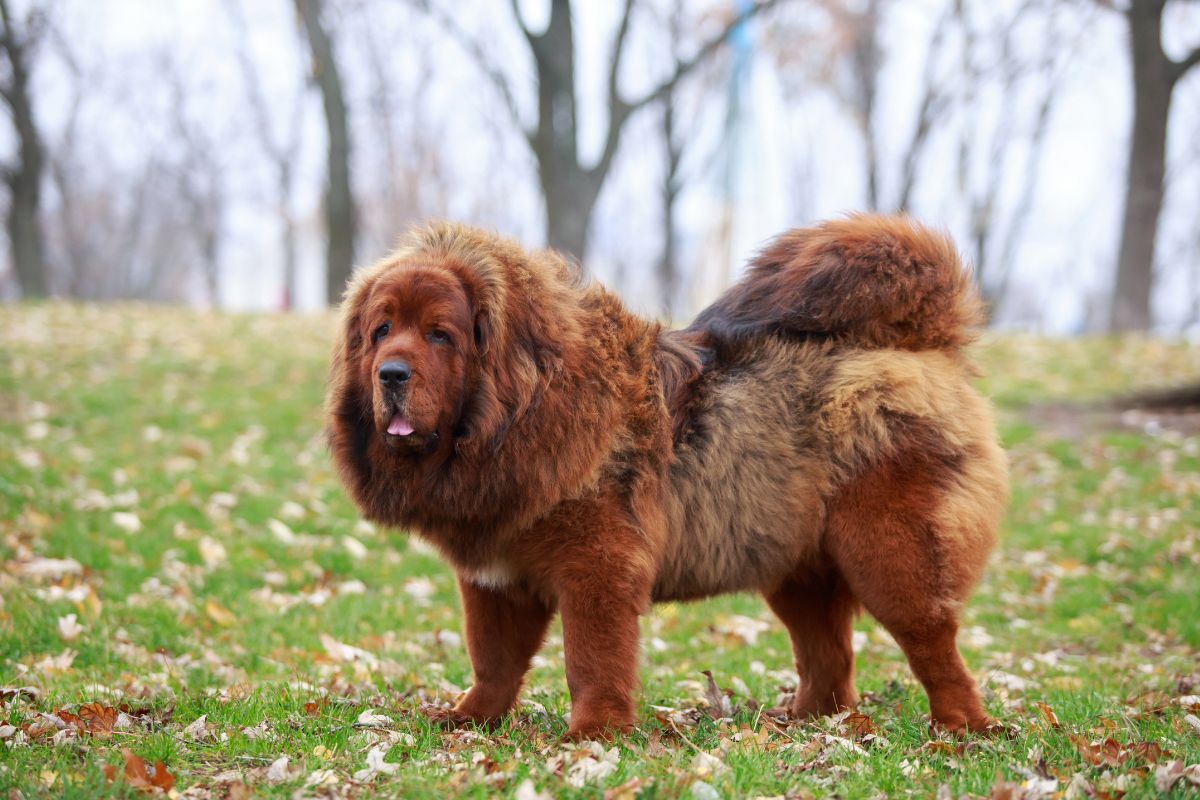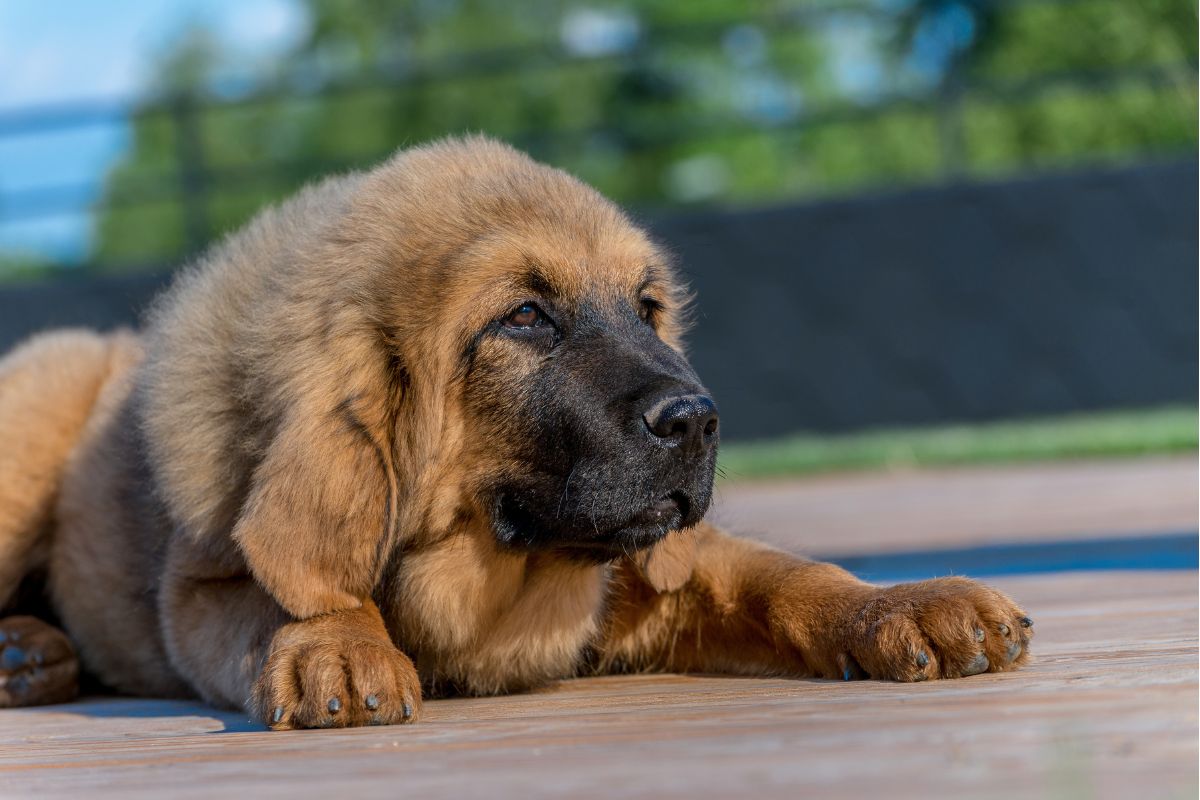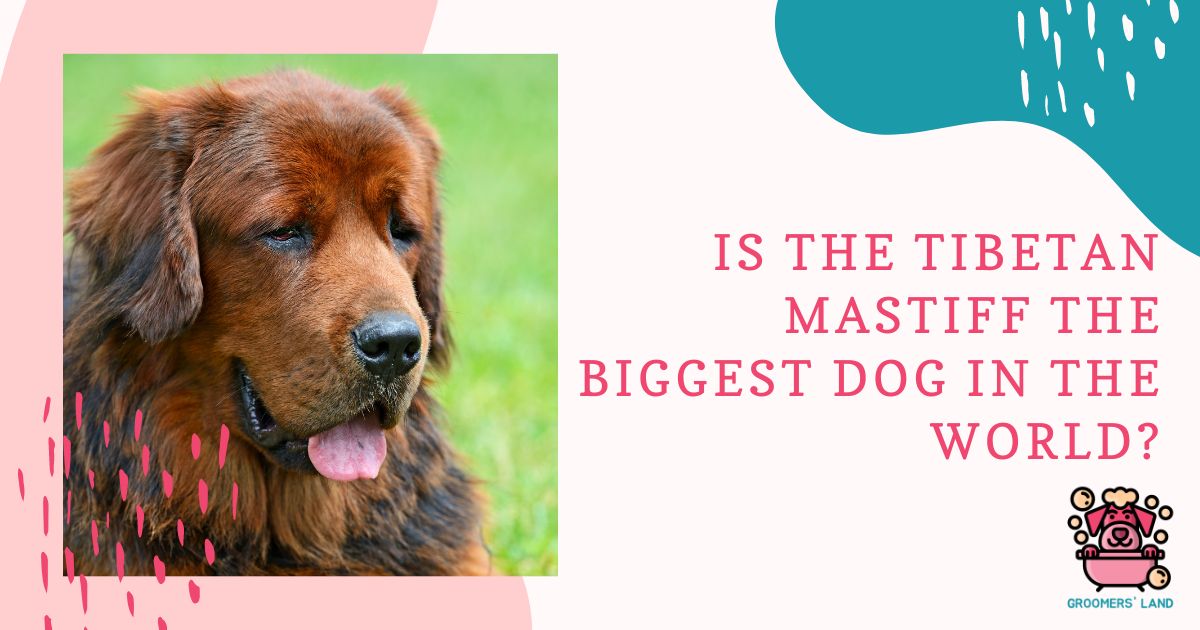Tibetan Mastiffs
The Tibetan Mastiff is a little taller and stronger than other common breeds. The Tibetan Mastiff is the biggest dog in the world and also falls among the most athletic dogs due to its natural agility and natural composure. Tibetan Mastiffs also come in various natural colors and a mane around the neck, especially the males.
Let’s dive deeper:
The Tibetan Mastiff Size and Appearance
Regarding size and appearance, a Tibetan dog has similar characteristics to a lion. The female Tibetan Mastiff that is fully grown can be around 24 inches (60 centimeters) or even more around the shoulder. On the other hand, male Tibetan Mastiffs are about 26 inches (66 centimeters) around the shoulders.
The male Tibetan Mastiffs weigh 90 to 150 pounds (40 kilograms to 68 kilograms) on average, while the female ones may weigh around 70 to 120 pounds (31 to 54 kilograms). The natural appearance of Tibetan Mastiffs has many different color variations. The thick coat of this breed may be brown, black, red, blue-gray, or gold.
In most cases, a Mastiff dog may have some markings around the eyes. These markings may spread through the throat, muzzle, and legs. The markings on the tail may vary from mahogany to silver, unlike the markings on the other sides.
The inner section of the coat has a smooth texture, while the outer section has a coarse and thick texture. Because of the natural features of this coat, the Tibetan Mastiff needs more grooming, unlike other dog breeds.
When spring and summer come, you may reduce the grooming level due to too much shedding. The tail of the Tibetan Mastiff is quite feathery, just like the arches and mane on the dog’s back in a curl.

What You Should Know About This Mastiff Dog
As a canine enthusiast, you should remember that the Mastiff is a general term for a tall dog, and almost all dog breeds of larger sizes. In most cases, all the larger dog breeds that take the Mastiff’s known name usually have a common heritage.
To this date, there are usually Mastiff breeds of different kinds. Some main mastiff breeds include the Spanish, English, and Tibetan Mastiff. These three breeds make up the main Mastiff breeds in the world.
Large dogs such as the Great Dane, Rottweiler, and Bulldog also fall under the Mastiff bracket due to their large physical size. These dogs’ considerable strength and size made them a good option for guarding livestock and hunting prey.
Is This Tibetan Dog Aggressive
This dog breed is not aggressive. The Tibetan Mastiff stays calm until provocation. Because of this reason, this dog may react and attack foxes or wolves. In the zero-case scenario, the giant Tibetan Mastiff remains calm.
The Tibetan Mastiff also has a powerful sense of self-awareness. Because of the awareness factor, this dog breed brings out excellent protectors. These dogs never react aggressively towards their owners or farm animals in the area where they live.
There is very little information about this dog breed attacking people or other animals worldwide. However, in America, some states have opted to ban this breed because of its size. This decision comes from the belief that dogs of larger sizes are more dangerous than dogs of smaller sizes.
Reducing the Aggressiveness of the Tibetan Mastiff
The Tibetan Mastiffs only listen to their real owners, just like the other breeds of typical sizes. You may take advantage of their level of obedience to you as the owner and perform some kind of training activities for them. You may give this dog rewards during the training sessions to make it comply even more.
When training the Tibetan Mastiff, it is essential to note that socialization is vital. You may choose to introduce a few strangers to your dog, study its aggression level, and then teach it how to be calm with the new presence slowly. With the new presence around, the dog will reduce its level of aggression and get a little calm.
You may choose to repeat the step above with different people for several days, and your Tibetan Mastiff may begin changing its behavior towards everyone coming around it. With all the proper training, your dog will get to know when to make an attack and when to remain calm.
While still on the dog intelligence part, you should maintain regular and continuous mental and physical stimulation. For the younger dogs of this breed, you need to use materials resistant to bites. To prevent any accidental choking situation in your Tibetan Mastiff puppy, you must avoid using smaller objects since they may accidentally slip into the throat.

Health Problems Associated With Tibetan Mastiffs
Like most other typical dog breeds, this largest dog breed also faces the risk of some health issues. Below are the primary health problems associated with Tibetan Mastiffs.
- Hip and Elbow Dysplasia
Once a dog’s hip fails to develop normally, it may suffer from this condition. It’s usually genetic in most cases, and the Tibetan Mastiff size makes it a great target.
Some specific bloodlines of the Tibetan Mastiff may suffer more from this condition than others. Breeders may take their puppies to vets for X-rays to check if the dog has hip and elbow dysplasia disorder. Early diagnosis may help reduce the strain of this condition and future transfers to other dogs of that bloodline.
- Hypothyroidism and Weight Gain
The Tibetan Mastiff also suffers from hypothyroidism since their thyroids are also prone to malfunctioning. This condition usually reduces the level of hormone production. In most cases, hypothyroidism gives out symptoms such as weight gain, infertility, poor coat quality, and frequent infections.
The Tibetan Mastiff is on the line regarding abnormal weight gain since it has an enormous dog weight. On most occasions, hypothyroidism may also lead to obesity. You may maintain the health of your Tibetan Mastiff by giving it regular exercises.
It is also essential to control the food you give this dog breed. You need to feed it in regular potions to prevent it from gaining excess weight.
- Skin Problems
Tibetan Mastiffs develop Demodex from time to time, a condition that mites cause. This skin condition is treatable, but it all depends on the dog’s genetic composition. You need to make sure that you brush the coat of your Tibetan Mastiff regularly. If you don’t perform this cleaning on the coat, parasites may attack the fur, causing skin irritation and other infections.
- Ear and Eye Issues
Progressive and retinal atrophy is the most common eye problems that may attack Tibetan Mastiffs. This dog breed is prone to these disorders due to its bloodline. If the eye condition is not treated, it may lead to blindness since the retinas may ultimately degenerate.
You may get to notice these conditions on your Tibetan Mastiff. In most cases, the eyelids may curl inwards, a condition known as entropion. On other occasions, the eyelids may curl outwards, known as ectropion. These conditions may damage the cornea if they remain un-treatable.
The Tibetan Mastiff has very narrow ear canals, making them prone to various ear infections. You must clean your dog’s ear canals more often to prevent ear infections.
- Canine Inherited Demyelinative Neuropathy
This condition mainly comes from the bloodline of a Tibetan Mastiff. This condition is quite rare, but it affects a good number of Tibetan Mastiffs across the globe. The canine demyelination neuropathy affects a dog’s nervous system, leading to problems in the legs and the brain.
In a worse case, the dog may ultimately lose the function of the forelimbs and hinds. In most cases, puppies under the 12th-week mark are the ones that suffer from this condition.
The History of the Tibetan Mastiff
The Tibetan Mastiffs were an image of protection in the Himalayan mountains. Other breeds, such as the English Mastiff, came from the Tibetan Mastiffs. There is no major record in place for this breed.
According to research, a gift of two Tibetan Mastiffs came to President Dwight D Eisenhower from Nepal in 1958. From this time, more Tibetan Mastiffs began coming from Nepal to the USA.
During the past years, the Tibetan Mastiff was not getting much attention, even with their importation from Nepal and India. It was until 2006 that most dog-keeping organizations, including the kennel club, recognized the Tibetan Mastiff.
The Largest and Most Expensive Mastiff Breed
The giant Mastiff dog breed ever recorded in history is the Zorba. This Mastiff is quite old and weighs up to 345 pounds (156 kilograms). The Zorba is also known as Aicama Zorba of La Susa. Despite being the largest physically, this dog is also the heaviest among all dogs, including all the other available dog breeds. The dog’s large size comes with a considerable price.
How Big Do Tibetan Mastiffs Grow
An adult male Tibetan Mastiff can grow up to 26 inches (66 centimeters) in height and weigh up to 160 pounds (72 kilograms). The female Tibetan Mastiffs may grow up to 24 inches (60 centimeters) in height and weigh up to 125 pounds (56 kilograms).
The Largest Mastiff Ever Recorded
The Zorba is the giant Mastiff dog breed ever recorded in history. This dog weighs up to 345 pounds (156 kilograms). This breed is also much taller than any other dog in its family or outside breed. Have You Heard About the TALLEST Dog in The World?

Summary
The Tibetan Mastiff is the giant dog breed in the world due to its physical appearance and weight. Almost all mastiffs have the same characteristics. Because of their natural features, it is pretty simple to distinguish between other dog breeds and the Tibetan Mastiff.

